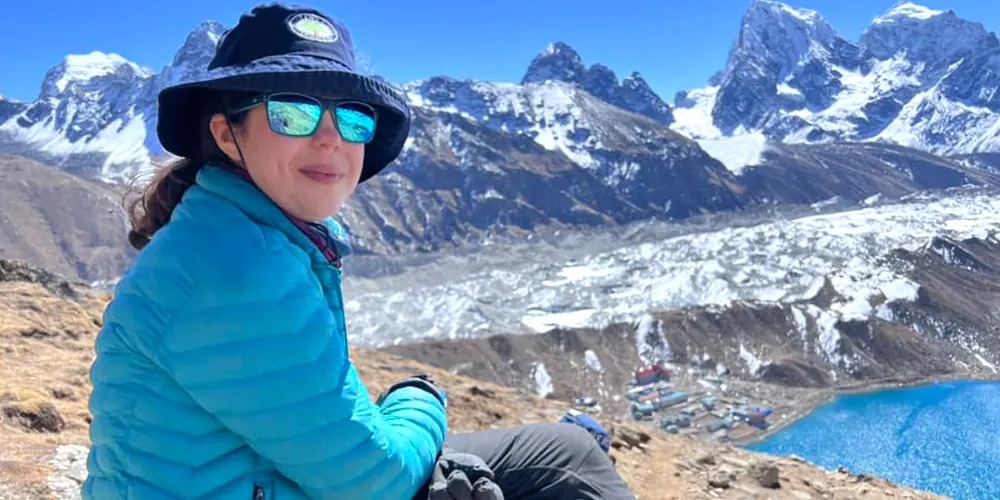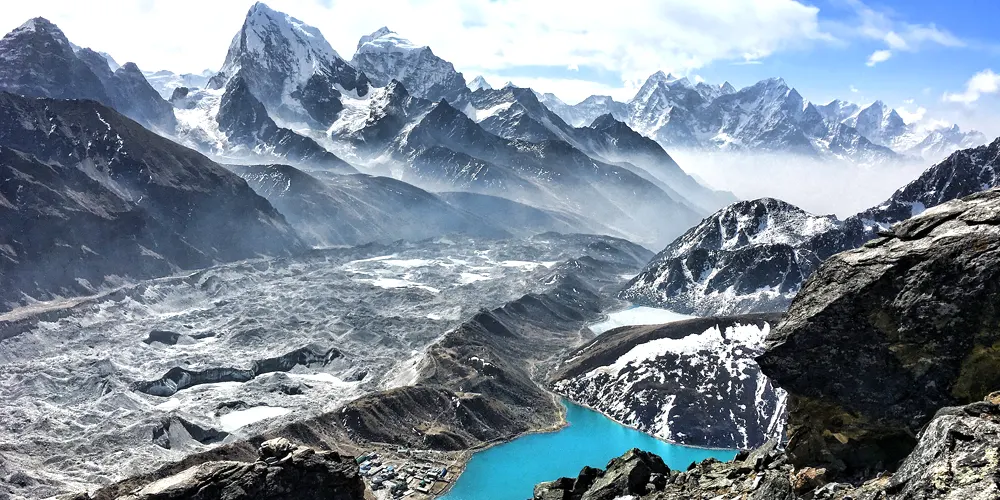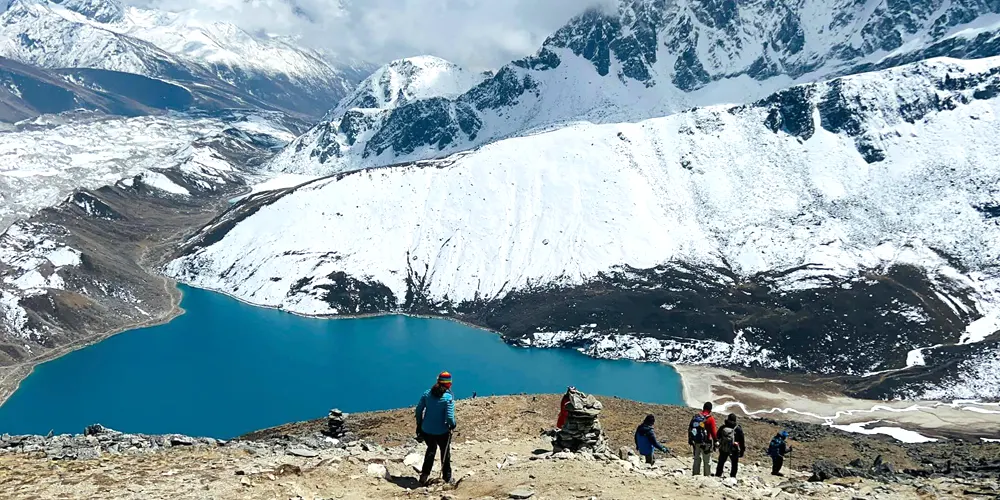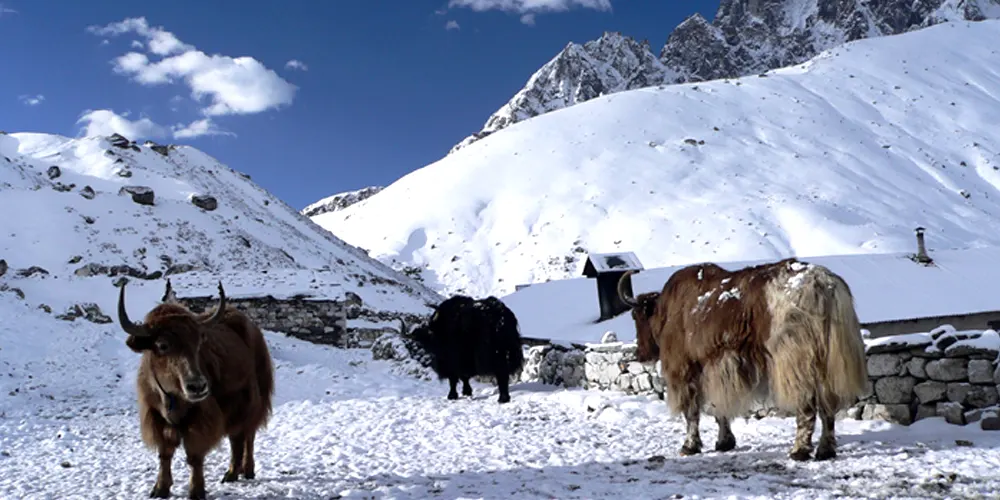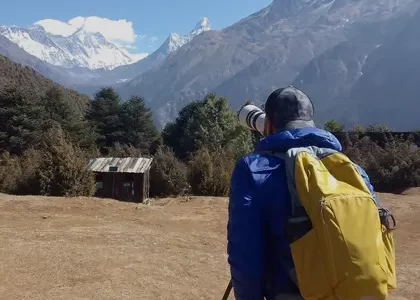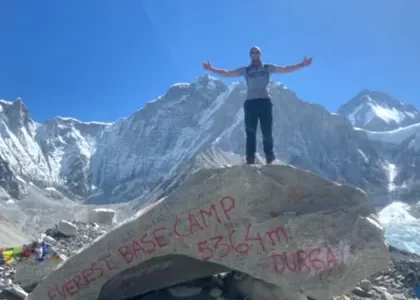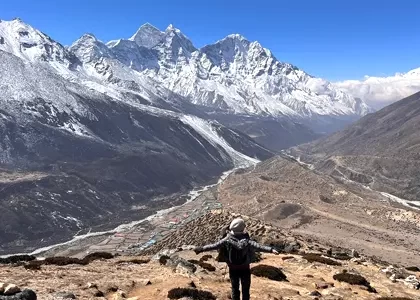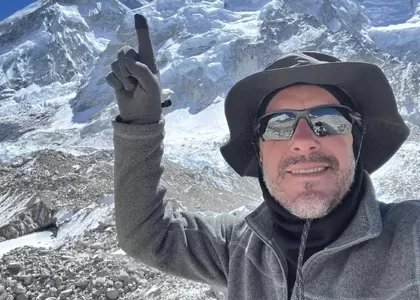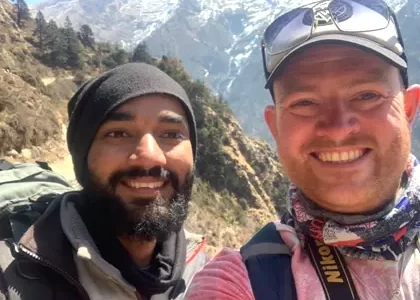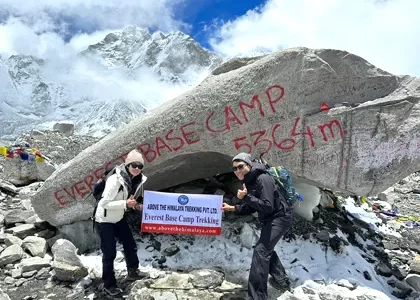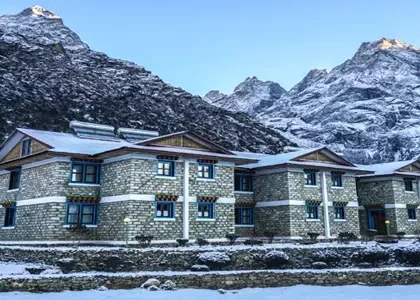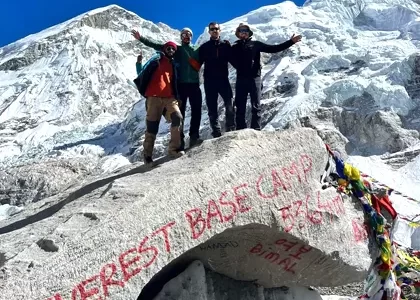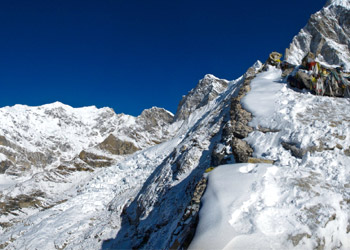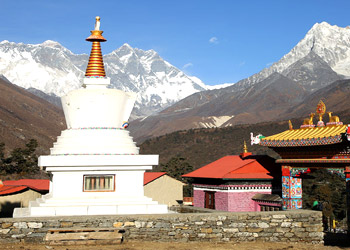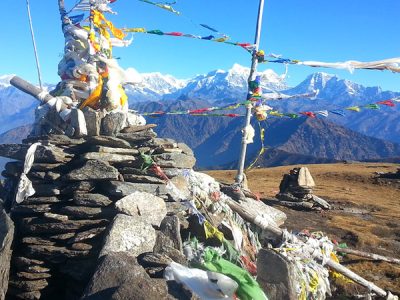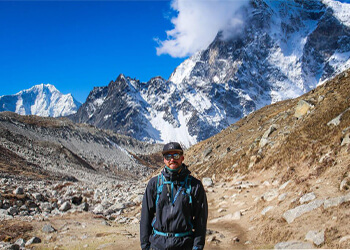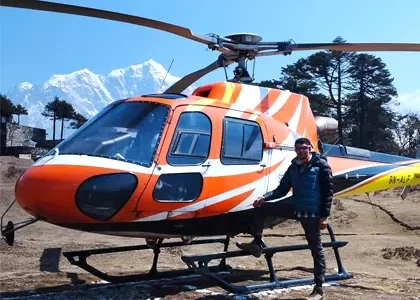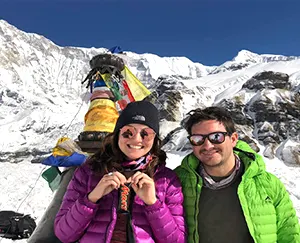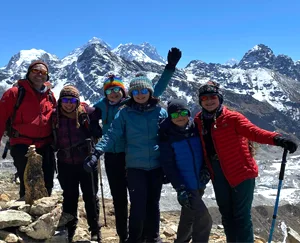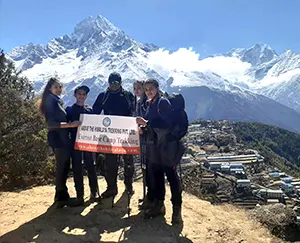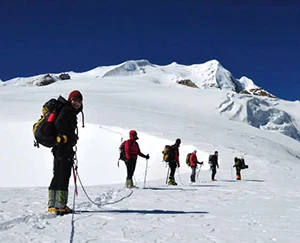Small Group Departure Dates for 2025 and 2026
Note: We can run a trip for solo travelers, couples, friends, and family with children. Our private trips run daily. For small group travel, please check the dates below. If the dates below do not suit you, please email us or WhatsApp us at +9779851095800 to travel on your preferred dates.
Gokyo lake Trek highlights
- Witness a wide view of the tallest peaks, such as Mount Everest, Lhotse, Makalu, and Cho Oyu, which can be seen from Gokyo Ri.
- View the Six Gokyo Lakes displaying its impressive turquoise blue colors in their water.
- Find tranquility on this trek as it attracts fewer people when compared to Everest Base Camp.
- Travel through the Ngozumpa Glacier, known as the longest glacier in Nepal.
- Witness both the stunning golden sunrise and sunsets.
- Discover local Sherpa settlements which maintain their traditional cultural heritage.
- Chance to see floras such as rhododendrons in red, pink, and white, as well as pine forests.
- Rest in the comfort of traditional tea houses, which operate as homestays.
- Witness the fourth and fifth Gokyo Lakes that offer exceptional vistas to hikers.
- Enjoy the full spectacle views of the Himalayan mountain range from Everest View Hotel.
- Those who spot Himalayan wildlife can observe elusive creatures such as musk deer alongside snow leopards.
- The world-class Lukla airport delivers one of the most exhilarating flight experiences.
Overview of Gokyo Lakes Trek
The Gokyo Lakes Trek traverses the Nepalese northeastern corner where altitude crosses from 4,700 meters to 5,000 meters. Gokyo Lake displays oligotrophic characteristics because it exists among freshwater reservoirs while six other lakes surround it with Thonak standing out as the largest among them.
Trail hikers at Khumbu encounter magnificent mountain views which include the Ngozumpa Glacier and Gokyo Ri together with bright high valleys. During the Gokyo lakes trek, trekkers walk through multiple rural communities while admiring the colorful monasteries that display the local culture. The journey becomes more delightful thanks to the Sherpa people’s welcoming spirit and the gentle movements of prayer flags.
Sagarmatha National Park contains rare wildlife which completes the atmospheric journey because nature enthusiasts love its array of birds and animals. At 4,750m (15,580 ft) above sea level, the village of Gokyo lies among the highest residential communities and rests at the base of Gokyo Ri.
The summit of Gokyo RI reveals a breathtaking scene where trekkers can observe the Ngozumpa Glacier with Cho Oyu, and Mount Everest along with Lhotse and Makalu in the background.
Why Gokyo Lakes Trek
The Gokyo Lakes Trek is an alternative to the crowded Everest region with magnificent Mount Everest views to offer visitors. The trek goes from Sherpa traditional towns into expansive yak grazing lands leading you into the breathtaking Gokyo Valley with its glacier-fed lakes that form stunning landscapes.
The Gokyo Ri climb reveals Everest as the main peak overlooked by Cho Oyu and multiple mighty peaks extending toward Tibet.
Apart from summiting Gokyo Ri, the trek provides an opportunity to observe all six enchanting Gokyo Lakes which perfectly mirror the surrounding mountains through their clear water reflections.
Hiking to the highest point on this trail reaches the same altitude level at Everest Base Camp and provides a mix of challenging adventures with life-long memories. The route transforms from tropical villages and thick tropical jungles into grassy rolling hills until it reaches its climax by exposing alpine views of snowy mountains.
The path reveals an extraordinary difference between verdant forests and exposed arid landscapes during your hike. Walking the Gokyo Lakes Trek leads you progressively toward Mount Everest’s beauty so that the travel experience matches the final point of arrival.
Can a beginner do the Gokyo Lakes Trek 10 Days?
You will find amazing views as well as special experiences on this trek, but being moderately fit is essential. The route includes challenging elevations alongside multiple daily walking periods between 4 to 7 hours across challenging paths. The Gokyo Lakes Trek 10 Days will require proper preparation for a beginner trekker to complete it.
Good stamina and mental resilience become essential requirements for this activity. The trek includes organizing acclimatization days to let your body adapt to high altitude conditions, which helps decrease the chance of altitude sickness developing.
The elevation level requires caution because ascending too fast can trigger symptoms of altitude sickness at higher heights. Trekking success depends on having both warm clothes and appropriate footwear, as well as trekking poles.
New hikers should get a guide to accompany them for safety purposes. Guides provide essential danger prevention as well as direction and important trail information to you.
A flexible attitude remains important because weather patterns in the area show significant changes. The most suitable times to undertake Gokyo lakes trek exist during spring and autumn since meteorological conditions tend to remain favorable.
The availability of helicopter rescue stands as an option for patients with severe altitude sickness, along with the necessity to purchase travel insurance, which includes coverage for high-altitude evacuations.
Beginners who prepare effectively alongside determination along with appropriate guidance have a good chance of finishing the Gokyo Lakes Trek while obtaining stunning Himalayan panoramas.
Our Guest Sharing Experience About Gokyo Lakes Trek
Itinerary of Gokyo Lakes Trek
01
Day 01: Flight from KTM to Lukla or Ramechhap to Lukla and trek to Phakding
Your trek begins with an early morning flight between Lukla and one of the two destinations Kathmandu or Ramechhap. The seasonal operation of Ramechhap flights needs you to first drive four hours to reach the boarding location.
Upon landing at Tenzing-Hillary Airport passengers can witness Everest Peak. You will spot deep Dudh Koshi Valley and surrounding peaks which are entirely covered with snow during your journey.
The nature of morning cloud cover may result in flight disruptions that lead to delayed arrival at Lukla. Upon landing you will receive food services at breakfast or lunch according to your flight timetable.
We will greet our porters after arrival at Lukla before starting the trip. The path proceeds alongside the Dudh Koshi River while crossing through forests and towns, and several bridges.
Your path will guide you to observe Nupla (5,885m), Kusum Kanguru (6,367m,) and the Kwangde range. The remarkable mountain peaks reach skyward as they control the landscape view which makes the trek more beautiful.
A steady and average walking pace will lead trekkers to Phakding between three to four hours. Your body will adjust to the high altitude as you appreciate both photographic sceneries and traditional village life.
The group will rest for tonight at a teahouse in Phakding, selecting a comfortable accommodation. Once you reach Phakding you can unwind while eating dinner for the daily hike preparations.
02
Day 02: Phakding trekking to Namche Bazaar
The next destination will be the crossing of Dudh Koshi River through an extended suspension bridge following breakfast. Experiencing this adrenaline-pumping bridge walk during day-time allows hikers to admire scenic vistas of the valley mixed with the fast-moving river.
Our path moves north along the riverbank and reveals multiple forests as well as small communities and stepped fields. Our view of the peaks reaches its peak when Thamserku (6,608m) steps forward.
Before reaching Monjo we experience the entrance to Sagarmatha National Park when the valley starts to tighten. The location requires visitors to register their trekking permits for entrance into the national park boundaries.
The guide will take charge of all required documents to keep everything organized. We walk another hour from Monjo towards Jorsalle where we stop for lunch.
A watercourse leads the path from Jorsalle until it reaches its second dangling bridge. We need to cross this bridge since it marks our end of the day before starting the climb towards Namche Bazaar.
We reach the Everest Viewpoint after climbing an intense slope which reveals an unforgettable sight. The visual sight of Everest for the first time during this demanding route makes the path incredibly fulfilling.
We proceed with our laborious climb to reach Namche Bazaar which is the lively Sherpa town. We stay overnight in a teahouse after finishing the check-in formalities upon our arrival.
03
Day 03: Acclimatization day in Namche
We have our acclimatization day at Namche Bazaar while one navigates through the Gokyo Lakes Trek. The Sherpa town exists as a picturesque valley in the middle of the Khumbu region.
Walk a short distance from town to reach the Everest View Hotel which provides awe-inspiring mountain views. Guests can take coffee outside to witness Everest peak and other mountains surrounding the area.
The cultural discoveries of Khumjung Village become accessible after Namche. The hike presents a chance to discover Sherpa traditional customs among elevated terrain.
Devote this day to getting lost among panoramic views extending from Everest all the way to its neighboring peaks. From your stand at Namche Bazar you will have dazzling views of Ama Dablam, Thamserku along with Nuptse, Kwangde, Tawche, and Lhotse.
The Namche market allows visitors to observe traditional Namche inhabitants enjoy cafes and bakeries. The sightseeing activities wrap up as you take advantage of the serene ambiance.
04
Day 04: Namche Bazaar to Phortse Thanga
As the Gokyo Lakes trek continues it climbs steadily while showing spectacular mountain views of the Himalayas. The taller snow-covered mountain summits emerge above our heads while we enter the deeper areas of the Khumbu region.
The trail path provides opportunities to observe pheasants together with musk deer and Himalayan Tahr groups. The trail moves down from Khumjung village and leads to the tiny settlement of Sanasa.
We start an orderly ascent from Sanasa toward Mongla which reaches an elevation of 4,000 meters. Here we have the opportunity to admire Ama Dablam along with Thamserku and Tawoche and Mt. Khumbila in the distance.
The people of Sherpa worship Khumbila Mt. (5,761m) because they see it as the holy protector of Khumbu. Most members of the community hold the belief that the holy Mt. Khumbila safeguards their territory and its people.
We continue our path down to the Dudh Koshi River where we need to cross the short bridge while being at 3,250 meters above sea level. The trail is decorated with thick rhododendron forests which produce brilliant colorations in the surrounding environment.
The trail terminates at Phortse Thanga which rests in the shadows of snow-coated peaks beneath. The sky is dominated by the two majestic peaks known as Tawoche and Cholatse, while we spend our night at that location.
05
Day 05: Phortse Thanga to Machermo
Tourists can now explore the Gokyo Lakes trek by advancing through regions of rhododendron and birch forests beginning at Dole. Local vegetation of hanging moss together with lichens contributes to the magical charm of the surrounding land.
Aside from pheasants mountain goats and musk deer the hike allows hikers to observe various types of wildlife. The challenge becomes even more extraordinary when unique wild animals cross our path during the trek.
From this path one can admire Cho Oyu peak together with Kantega and Thamserku mountains. Several summer communities line our path toward the brief visit at Luza which stands at 4,360 meters.
We start ascending while the path transitions from stones to little rhododendrons. The pathway changes from forested terrain to thorny shrubs as the altitude enhances our elevation climb.
At higher altitudes scrub junipers emerge as visible features in the landscape. The valley of the Dudh Koshi turns into a deep canyon with overwhelming rocky cliffs rising to incredible heights.
The trail we follow slopes down while we overlook the powerful Dudh Koshi River. Our picturesque path reveals both small farming communities and shining sand deposits between these settlements.
Machermo presents itself through the breathtaking stream emerging from Kyajo Ri and Phari Lapche peaks. The water from the stream enters the Dudh Koshi adding its appeal to the valley.
Our arrival in Machermo happens during lunchtime and we stay for the evening rest. The peaceful village functions as an important rest area before we continue our upcoming ascent.
06
Day 06: Machermo to Gokyo
A daily hike from Machermo takes visitors through the widespread Gokyo Valley into the area where Gokyo Lake becomes visible. The path gradually rises while passing multiple chortens until reaching Pangka at 4,480 meters.
We reach a small stream by crossing an iron bridge before carrying on through the valley. Surrounding Gokyo village we find Longpongo Lake at an elevation of 4,690 meters which marks the initial divine lake of the region.
The second lake, Taboche Tsho, shimmers beautifully under the sun. The lake reflects the peaks surrounding it with turquoise blue waters that form an awe-inspiring scene.
Moving forward from Longpongo the trek leads to Dudh Pokhari located at the third position. A forceful stream operates as a bridge between this lake and its predecessors to boost the stunning beauty of the area.
Gokyo Village faces Cho Oyu near the largest glacial lake within the area. The small settlement provides gorgeous alpine conditions for the trekkers visiting the area.
Those visiting this site have the chance to view Cho Oyu Mount alongside several nearby peaks such as Gyachung Kang, Lhotse, Makalu, Cholatse, and Tawache. We spend the night at a teahouse after appreciating the magnificent scenery.
07
Day 07: Gokyo Lake Explore and trek down to Dole
Our day starts by visiting Gokyo Lake followed by its adjacent territories. The path by the lakes requires walks which allow us to observe the quiet surroundings while various peaks nearby invite us to their summits.
The route requires half an hour of tough climbing that leads us to a mountaintop where prayer flags wave in the wind. The sighting of Ngozumpa Glacier and its sparkling lakes takes place from this vantage point.
We pass through the fourth lake Thonak Tsho and the fifth lake Ngozuma Tsho during this trail. The high-altitude region attains its dramatic appearance because of these glacial lakes.
Visitors encounter extraordinary views that extend across the entire landscape from western to eastern directions at this summit. The scene extends from Cho Oyu (8,153m) to Gyachung Kang (7,922m), Everest (8,848m), Lhotse (8,501m) while Makalu remains further away.
Our descent to Dole began during the afternoon while we savored the sights before us. Additional group members who finish early can venture onto the ridge behind Dole to witness incredible valley sights.
Lunch in Gokyo follows our sightseeing activities. Trekkers who wish to climb Gokyo Ri can take the opportunity to gain this exceptional view if they have sufficient time and energy.
08
Day 08: Dole trekking down to Namche Bazaar
The route goes descending steeply from Dole while walking through magical rhododendron forest valleys. The path follows down through the valley providing intermittent views of the neighboring sceneries.
Travelers must cross a suspension bridge that spans across the river at Phortse Thanga. From the hill summit we gain breathtaking views of the Dudh Kosi River slipping down in front of us.
The track proceeds to lead visitors toward the peaceful village of Khumjung and further extends back to Namche Bazaar, where you meet the lively locals again.
09
Day 09: Namche Bazaar trekking to Lukla
From Namche Bazaar the trail takes us down toward the Dudh Kosi River until we end at Jorsalle village. Through these forests the trail guides us towards Poperyul and Bhotekoshi valley where magnificent magnolia trees grow alongside enormous fir trees alongside colorful rhododendrons.
Phakding serves as our temporary halt during which we walk beneath the trees which consist of rhododendrons and blue pine forests. During our adventure, we have the opportunity to admire splendid views of Kusum Kangaru and the Mt. Kwangde range.
We stop at Lukla for lunch following our extended hiking session before making flight reservations. We spend our first night in the town while enjoying hot showers followed by investigating the nearby “Thangka Painting School“.
To honor our parting with the trekking crew, we will have a meaningful farewell dinner tonight.
10
Day 10: Flight from Lukla to Kathmandu
Our team will conclude its Gokyo Lakes Trek by sending off its porters and guides before taking a flight back to Kathmandu. Hotel accommodation with a comfortable room will be available immediately after arrival followed by hot shower and plenty of rest before starting to relax.
Trip Extension
Suppose you have more time in Nepal after this trip. In that case, we can help you to extend your trip by running different treks in Nepal, tours in Bhutan and Tibet, Jungle safari tours at Chitwan, Bardia, and other National parks, Nepal luxury hotel booking, Rafting, Ultra-light flights, or any other travel-related services. You can get more information here.
Includes/Excludes
What's Included?
- A trekking guide certified and licensed by the government has training in high-altitude sickness and first aid.
- Local trekking porter from Lukla
- Trekking staff, food, accommodation, salary, equipment, insurance, and clothing.
- Kathmandu to Lukla and back Kathmandu flight ticket.
- Local Tea houses, also called guest houses/ lodges, twin sharing during your journey.
- Your daily meal (breakfast, lunch, and dinner). You can choose your meals from the menu, which includes different types of food.
- Sagarmatha National Park Everest trekking permit
- Local permit fees for Khumbu Gaunpalika
- The guide will carry essential medical supplies and a first aid kit.
- Above the Himalayan duffel bag. ( If you need to, please let us know before you book the trip and remind us before you arrive in Kathmandu so that we can easily prepare.)
- All the trip information and details for the trek.
- Above the Himalayan Gifts and Trekking certificate after finishing your trek.
- We offer you one dinner in Kathmandu in a Nepali restaurant
- Government taxes and service charges.
What's Excluded?
- Any services in Kathmandu
- Airfare to Nepal
- Nepal entry visa fee: you can get a Nepal visa upon arrival at the Airport.
- Alcoholic, hot and cold drinks, hot water, hot and cold showers.
- Personal expenses include laundry, telephone calls, sweets, snacks, beverages, bar bills, and camera battery charging.
- Travel Insurance should include both rescue and medical assistance.
- You can buy and rent personal trekking equipment in Kathmandu trekking stores.
- Gratitude to the tour/ trekking staff and driver
- Other of your expenses that are not mentioned are costs included in the section.
Route Map & Altitude Chart
Best Season for Gokyo Lakes Trek
Weather conditions stand as the most important variable for Gokyo Lakes Trek since the weather behaves unexpectedly. Your decision to trek at optimal seasons provides clear visibility and perfect terrain conditions while granting you breathtaking mountain views.
Autumn (Mid-September to November)
Climbers who wish to experience the Gokyo Lakes Trek find this period most suitable since monsoon rains have stopped and skies have become clear with excellent sightlines. Through this season hiking is most appealing to trekkers because the terrain is dry and the air remains crisp. People enjoy additional cultural experiences because the season lines up with Nepal’s largest religious holidays, Dashain and Tihar.
Spring (March to April)
Spring provides an ideal season for trekking because rhododendrons bloom while the weather stays pleasant. The climate enhances during mid-March to unveil spectacular views of Everest peaks together with their surrounding peaks. The trek experiences enhanced beauty from the colorful forest environment together with various bird species spotted along the way.
Winter (November to February)
The early part of winter during November delivers exceptional viewing conditions and picturesque mountain vistas together with substantial temperature decreases. Heavy snow accumulates across the area in December thereby making all trails difficult to navigate.
During January and February temperatures fall to -10°C while the trekking conditions become difficult. The cold temperatures fail to defeat the stunning visual effect of the snow-covered environment.
Summer (May to June)
Travelers can complete trekking in the pre-monsoon period but the absolutely dangerous rainy season arrives in mid-June. Mud and slippery conditions form on the trails due to the combination of heavy clouds with mountains that remain hidden from sight.
Crucial flight routes from Lukla will be delayed for multiple days because heavy rain along with leeches become major concerns during July and August which makes this period dangerous for trekking visitors.
Walking in a suitable season results in enhanced safety conditions while simultaneously leading to optimal mountain views.
How Hard is Gokyo Lakes Trek
The Gokyo Lakes trek in Nepal is considered moderate to difficult, making it accessible to both experienced trekkers and beginners with good fitness levels. It’s a popular choice for those seeking less crowded trails while still experiencing the beauty of the Himalayas. While the trek does not involve high passes or technical climbing, it does require trekking on steep uphills and downhills across rough terrain.
Fitness and stamina are important, as the trek typically involves 5 to 6 hours of walking each day, covering distances of 9 to 10 km. Despite the relatively manageable duration, trekkers will feel challenged at high altitudes. The trek reaches altitudes between 4000 m and 5300 m, where the air is thin, and altitude sickness can affect many individuals. Therefore, it’s crucial to be prepared for the physical demands of the trek and take time to acclimatize along the way.
Gokyo Lakes Trekking Required Permits
Two necessary permits are needed when beginning the Gokyo Lakes Trek. The entry requirements for the region are the Sagarmatha National Park Permit and the Khumbu Pasang Lhamu Rural Municipality Permit.
The Sagarmatha National Park Permit requires a payment of around $30, which is used to protect this untouched environment with rare wildlife and traditional culture.
On top of the official permit, you must acquire the Khumbu Pasang Lhamu Rural Municipality permit for around $20. The permits serve as the main requirement for accessing the region legally while simultaneously protecting the local environment.
While traversing the trail, you need to safely maintain your permits since they can be checked anywhere at the checkpoints.
These permits help collect the funding and use them to improve the overall regional infrastructure and development of tea houses. The fund will help in enhancing the providing better safety while maintaining the traditionality of the route and region.
You can obtain both permits from the Nepal Tourism Board office in Kathmandu or at checkpoints in Monjo. You would need a passport-size photo and a copy of your passport to get the documents.
If you find this process to be a hassle, you can take our package, which includes the permits within it and also licensed guides who will take care of it for you.
Cultural Encounters on the 10 Days Gokyo Lakes Trek
The Gokyo Lakes Trek provides many cultural opportunities as Sherpa communities reside there. The trekking pathway leads you through many villages, such as Namche Bazaar, Machermo, Dole, and Phortse Thanga, that let you participate in native customs.
Your path includes prayer flags and mani walls along its length, which brings religious meaning to your expedition. Visitors to these villages can obtain knowledge regarding Buddhist traditions that originated from the Sherpa people’s cultural heritage.
Anyone stopping at Namche Bazaar can explore the important trading and cultural center that displays Tibetan arts as well as local handicrafts. The local tea houses welcome visitors with traditional cooking of dal bhat along with butter tea within their warm hospitality.
Sherpa family accommodations allow travelers to listen to personal stories from Sherpas about their mountaineering experiences while learning about their Himalayan daily life. Building meaningful bonds with local people develops through the combination of traditional Sherpa hospitality with communal food sharing.
The path features numerous monasteries that provide an opportunity to learn about the Buddhist religion while special ceremonies become visible during dedicated festival days, such as Mani Rimdu.
The interactions with Sherpa monk experts deepen your understanding of Sherpa cultural practices while community customs must be respected. Because of cultural interactions, the Gokyo Lakes Trek provides visitors with a richer and more memorable adventure.
Wildlife and Flora during Gokyo Lakes Trek
During the Gokyo Lakes Trek, visitors can experience the wide range of Himalayan natural ecosystems because this trail constitutes a sanctuary for wildlife and plant life.
The unique Himalayan species like the musk deer, Himalayan tahr, and rare snow leopard appear occasionally during your hike across the area. The mountain terrain of high altitudes supports these animal species because it provides suitable shelter as well as sustenance.
The trails of this trek stay quiet, which generates more possibilities to see magnificent animals. It provides excellent bird-watching opportunities for those who enjoy pheasants, with the Danphe representing Nepal’s national symbol, appearing frequently during observances.
From the bottom to the top, you will encounter pine and juniper forests, followed by alpine meadows taking over the forested areas. During the spring season, the rhododendron flower adds bright colors among the other local plants throughout the trip.
The Gokyo Lake region hosts glacial lakes that maintain their own aquatic ecosystems where birds from different regions come to visit.
Besides being the local main attraction of the area, the land-dwelling yaks feast on mountainside pastures. Maintaining respect toward both wildlife and plants within this Himalayan area helps protect its sensitive ecological system forever.
Altitude Sickness and Acclimatization on Gokyo Lakes Trek
Trekking at Gokyo Lake presents altitude sickness as a frequent health challenge for all hikers due to its elevated locations. Climbing higher elevations exposes your body to a thinning atmosphere, which needs some time to accept the diminished oxygen availability.
Gokyo Lakes Trek requires acclimatization because it prevents altitude sickness, which presents symptoms from mild headaches and dizziness to severe cases needing emergency descent.
During the trek, you will need to stop at designated points to acclimate your body system. The days will involve either resting or performing brief hikes to higher ground before descending back to lower borders for better adaptation to altitude changes.
One of the popular spots for acclimatization is at Namche Bazaar, where you can take short hikes to Everest View hotel and Syangboche Airstrip.
The successive elevations during the ascent decrease the probability of developing altitude sickness. The time requires proper hydration together with nutritious food and proper physical workload for optimum health.
Nausea, together with headache, dizziness, and fatigue, represent the primary indications of altitude sickness.
Anytime you develop these symptoms, you should immediately tell your guide and execute proper safety protocols.
Descending to a lower altitude stands as the most suitable remedy for severe manifestations of altitude sickness.
The Gokyo Lakes Trek requires you to move at your own pace while listening to signals from your body because altitude sickness can be avoided by strictly adhering to your guide’s instructions.
Physically fitness for the Gokyo Lakes Trek 10 Days
The Gokyo Lakes Trek needs participants to have both moderate and high fitness levels for its difficult high mountain features and elevation elevation conditions. Good endurance and stamina combined with daily trekking hours between 4 to 7 hours will challenge you through your mountain hike.
You need cardiovascular fitness to deal with physical strain because strength exercises targeting primarily your legs are essential for handling steep uphill paths. Try engaging in jogging, cycling, and swimming for endurance and stamina, together with squats, planks, and lunges for strength.
During your trek, vulnerability to accidents stems from core exercises that simultaneously enhance your balance capabilities. Acclimation rest periods throughout the adventure let your body become accustomed to the declining atmospheric oxygen amounts at elevation heights.
The process of adapting to extreme conditions depends heavily on keeping yourself hydrated as well as nourished properly, and getting enough rest. The development of mental resilience becomes essential because fatigue and discomfort are likely to affect you along the way.
A travel backpack that does not weigh too much and hiring a porter service helps ease the workload during your trek. Hikers who train their bodies for one month prior to trekking will boost their chances for success and create a positive and fulfilling outdoor experience.
Gokyo Lake vs. Other Trekking Routes
The trekking route to Gokyo Lake provides visitors with an exclusive experience, unlike the popular Everest Base Camp trek.
Gokyo Lakes Trek stands apart because it provides limited hiking activity with others. With fewer trekkers drawn to Gokyo Lake visitors can experience a peaceful environment that provides quietude. Trekkers experience a more peaceful setting on the path to Everest Base Camp since the area is typically overcrowded with visitors.
During the Gokyo Lakes Trek, you can appreciate pristine views of Mount Everest together with Lhotse, Makalu, and Cho Oyu from Gokyo Ri, as other trails receive minimal tourist traffic.
Travelers can experience the distinctive attraction of exploring multiple turquoise glacial lakes because they stand in sharp contrast to the white snow-covered mountain heights.
The Gokyo route provides better opportunities to observe scarce wildlife, including snow leopards and musk deer. Tourists who choose Gokyo instead of Everest Base Camp will experience calm treks alongside breathtaking views, which include distinctive topography.
Trek Luggage
While trekking in Gokyo Lake, you need to pack well. It would help if you had enough warm clothes for the cold weather in the mountains. The Kathmandu to Lukla flight operates with a strict weight limit of kilograms. They allowed you the most significant limit of 10 kg of luggage and 5 kg of your day pack.
So, you can only take the greatest of 15 kg of luggage, including your day pack. You weigh your bag before you leave your hotel for the Trek. Most hotels in Kathmandu have a weighing scale.
If you have too many items, you can take out the items and leave them at your hotel or our office. You can buy most small daily necessities like toilet rolls and Snickers bars at Lukla and Namche. You can get the water in Lukla, so it is unnecessary to get it from Kathmandu.
The porter will take your main bag and your day bag. You can only take water, one small jacket, chocolates, and bars. Please package all your items in your main equipment bag.
Drinking water during the Gokyo Lakes Trek
You can take chlorine/Iodine tablets on the Trek with you. You can also buy water purification tablets in the Thamel trekking or medical stores. All tea houses have mineral water and boiled water for trekkers at a higher cost.
We don’t tell you to buy Mineral and bottled water while on the Trek. Plastic bottles are difficult to dispose of and have become an environmental problem.
You will get free regular water, and you can use your Chlorine/Iodine tablets to drink it. To make it easier, you can bring two water bottles, as you can drink 3 liters of water per day for your Gokyo Lakes trek.
Shorten the Trek by flying back by Helicopter
A helicopter flight back may be a remarkable way to end the journey. After the Trek, you may take a helicopter from Gokyo Lake to Lukla or Kathmandu. From the plane, you can view several mountains. We can see Makalu, Kanchenjunga, Everest, and Lhotse.
If you return by Helicopter, the Gokyo Lakes trek will take a few days. It is possible to fly to Lukla or Kathmandu.
Safety and satisfaction
Our company’s priority is the safety of our guests. We want all our customers to get to their destination without any issues. As a result, one of the most knowledgeable and experienced Trek guides is with you.
The guide will carry all the necessary gear and a first aid kit for safety, but we ask that you bring some of your medication on this Gokyo Lakes trek.
In an emergency, if any of our customers experience problems due to altitude sickness, we will contact you or our guide in other unexpected circumstances. We are always there to deploy a rescue helicopter to return them to Kathmandu or a lower altitude.
Average Group Size
So, what size groups would you join if you went on the Gokyo Lakes trek? We do keep our groups small, except for a family trek. We welcome you, whether alone, with a partner, or with a family.
As you know, our trekking groups consist of six to eight people. From our perspective, this keeps things more personal.
Some vast groups have been on the Gokyo Lakes Trek but only have one guide. But, a smaller group is more personal, and you get to know your guides better since they are wonderful people. More personal interactions occur in smaller groups.
It’s lovely to have a team to assist you in getting back. During your bad days when you’re feeling a little off and getting down in the house, you know. The closer your team is, the more likely you will reach the Everest region.
Yet, since it is your journey, you can select the people you go with. You may trek with your friends, coworkers, or family and have a great time.
Travel Insurance for Gokyo Lakes Trekking
While we have an excellent program for Gokyo Lakes Trek, the trail guides have years of expertise in bringing people in and out. It’s always necessary for us to have evacuation procedures.
We want to make sure that our guests are comfortable on the journey. Suppose they become ill or are unable to continue the trip then we must take them to a lower altitude. They can come back to Kathmandu, or they can continue traveling if they choose.
So, before beginning the walk, you get trustworthy travel insurance. Travel insurance coverage can support your evacuation.
During your Gokyo Lakes Trek. There can be a risk of getting injured due to a twisted ankle. High altitude issues or even your body is not adjusting well. We take every precaution and go forward.
With a very high success rate, we want to ensure that we evacuate as soon as possible. Your travel insurance will cover the expenses. It will handle the accident during the Trek and arrange a helicopter rescue.
Gokyo Ri Views
In the Everest region (west side of the Ngozumpa glacier) at 5,357 meters (17,575 feet), Gokyo Ri is one of the region’s best viewpoints. It is one of the most popular trekking trails due to its scenic vistas, even when the routes are slightly off from the tracks of the Gokyo Lakes trek.
This high point offers a breathtaking view of the mountain peaks above 8000 meters, which are Mount Everest (8848 meters), Makalu (8475 meters), Lhotse (8501 meters), and Cho Oyu (8153 meters).
Apart from these gigantic peaks, you will also experience the mesmerizing beauty of several ranges below 7000 meters. Alongside the peaks, the Gokyo Lakes trek and Gokyo Ri adventure takes you through a small settlement made of stone houses, considered the world’s highest settlement.
Likewise, this journey walks you through off-beaten tracks and narrow trails as you finally reach the base of the Gokyo Ri.
The base of Gokyo Ri presents five glacier lakes. These turquoise bodies offer a pristine view, making the trekking destination worth it. Altogether, Gokyo Ri is perfect for travelers who wish to experience the Himalayas up close while ascending a unique landscape.
Gokyo Lakes Trek necessary gear and equipment
Gokyo Lakes trek goes up to 5,000 meters, and the walk follows a challenging, upward route. So, it needs careful planning and preparation. You must bring the essential supplies and gear for this Trek. You can only get the most miniature clothes and equipment for this Trek. You can prepare for your journey by using the list that follows.
- A sun hat or scarf
- A winter hat, an insulating hat, or a wide-brimmed hat
- Headlight with extra batteries
- Sunglasses with UV protection
- Sunscreen
- Wet tissue or face wipes
- Hands
- Woolen winter gloves
- Lightweight gloves
- Base layer
- Thermal wear
- Long-sleeved shirt
- Hooded rain jacket
- Hiking shirts
- Trekking pants
- Fleece jacket
- Down jacket
- Lightweight cotton pants
- T-shirt
- Sweater
- Underwear (4-5 pairs)
- Waterproof jacket and pants
- Thick wool socks (2-3 pairs)
- Hiking Boots
- Comfortable trekking sports shoes
- Essential gear
- Thermal bottle
- Water purification
- Backpack or daypack
- Trekking pole
- Sleeping bag (-20 degrees is best for high-altitude trekking)
- Personal accessories
- Medium-size drying towel
- Toothbrush
- Toothpaste
- Deodorant floss
- Biodegradable bar soap
- Nail clippers
- Money
- Watch
- Cell phone
- Camera
- Extra items
- First aid kit
- Additional passport photos and photocopies of your passport
- Binoculars
Most Asked Questions by Travellers
The Gokyo Lake trek is 10 days long from Kathmandu. We can also combine the trek with Everest and other high passes from 15 to 18 days long.
Gokyo Lake is famous for its highest freshwater lake system globally. It is a place that presents a perfect blend of serenity and adventure. This spectacular high-altitude trail is ideal for those who want to avoid the crowds and still gain stunning views of Mount Everest.
You will be starting this trek from Kathmandu at an altitude of 1400 meters. The largest size of this trek is Gokyo Lake, at an altitude of 4790 meters. During this trek, you will be gaining height slowly.
You will need two permits to trek Gokyo Lake. A TIMS permit is the first permit you must have for walking in the Himalayan region of Nepal.
The Sagarmatha National Park permit is the second permit needed to enter the Park.
Reviews on Gokyo Lakes Trek
![]()
![]()
![]()
![]()
![]()
Based on 300+ Reviews

Tria & Adrian Lynch
Melbourne, Australia
Gokyo - Everest Base Camp Trek October/November
We enjoyed a two-week adventure on the Gokyo Lake trek. We did it in October/November, coordinated by Puru at Above the Himalayas. It was our honeymoon, and Puru and his team took extra care to ensure we were well looked after in every respect.
Ramchandra, who went with us, was an excellent guide. We have a charming Nigma Sherpa (our porter). Who lightened our load and kept us entertained with his jokes and warm personality.
Ram shared his wealth of knowledge about the region, its mountains, and its people. He was an absolute gentleman who served us with selfless Nepalese hospitality.
From attending to minor ailments to ensuring that each room is. They booked into had the best view. He ensured we made the most of our adventure through the Himalayas.
Puru also attended to hotel and flight amendments and confirmations. His team with a least of fuss.
We are happy to recommend Ram, Puru, and Above the Himalayas. They are excellent and professional. They offer a good value service for a memorable adventure in Nepal.
Tria and Adrian Lynch
Melbourne, Australia

Stephanie Rich
Canada
Best holiday planner for Nepal
The Gokyo Lake trek is the most fantastic trip. Above the Himalayas, I took good care of myself and my partner, and from arrival to departure to my home. This company treats its guests like their family.
The information they provide before the trip. Our guide, the porter, and the service they handled were phenomenal. I am thrilled to recommend using them for your next adventure in the Himalayas.
Stephanie Rich
USA

Sylvie Houghton
Canada
Gokyo lake trek in October
Phurba Sherpa was a fantastic guide for the Gokyo Lakes trek. Through good and hard times, he was always helpful and had a smile on his face.
When I was a little afraid of trials, he held my hand. When I was sick, he carried my bag; when I was weak, he fed me Mars bars.
I would recommend Above The Himalayan Trekking and Phurba as a guide. recommended
Sylvie Houghton
Canada

Richard Solan
Canada
Beautiful trek, Excellent guide
We did the Gokyo Lake trek as a private trip for two-person groups. The experience was terrific. From arrival at the Airport to departure, all went very well.
Our guide, Basu, went above and beyond during the Gokyo Lake trek journey. They arrange everything. He made sure we had room in the tea house.
I booked in advance and helped us change our flight ticket from Lukla as we extended our trip one more day. The views from Gokyo, RI, were spectacular, and don’t miss it.
Richard Solan
USA

Michale Fernandez
USA
10 Days Gokyo Lake trek best trip ever
My husband and I returned from a 10-day Gokyo lake trek with Above the Himalayan trekking.
Before the trip, we communicated all our queries on planning the trip to Mr. Puru. The trip plan was great, and we got all our questions in a detailed way.
Our trekking guide was Suresh, and he was a fantastic guide. We had so much fun with him.
He also chooses the best porter from Lukla for us. I would recommend this company to anyone for the Gokyo Valley trek.
Michael Fernandez
USA

Ashley Chan
Penang, Malaysia.
Trek to Gokyo Lake, Highlly recommended !
Our Gokyo Lake trek was beautiful. We enjoy every step of the Gokyo Lake trek trail. Our guide, Ram, and porter, Surya, were very kind and motivational.
We had a great view of the mountains and enjoyed the local culture.
Ash Chan
Penang, Malaysia

Jin Xia
Beijing China
Best company for Gokyo lake trek, highly recommended
Puru,
Thank you so much for arranging this amazing Gokyo Lake trek. Everything during the trekking is fantastic. When I decided to do the trekking at the beginning, I was a little bit worried about the safety of the route.
Then I searched the internet and our Puru’s trekking agency. The recommendations from other clients and the itinerary of their plan led me to try to contact Puru by mail.
After that, everything went from the airport to pick up at midnight. Everything is excellent for the day view in Kathmandu and the 10 days of trekking.
Especially my trekking guide, Dipak. Without his help, I couldn’t have reached the Everest and Gokyo Lake trek.
That’s an excellent trip that Puru arranged for me.
Thank you very much
Jin Xia

Allan Hawkins
Canada
Everest & Gokyo treks and Nepal cities tour
Our trip to Gokyo Lake Trek was very successful. It was enjoyable and spectacular, thanks to the organization—their skills, flexibility, and knowledge of Above the Himalayan Trekking.
The company and its owner, Puru Timalsena, were excellent. We would recommend Puru and his company. Even though we developed our itinerary, Puru made it happen seamlessly.
His well-being focused on our well-being, enjoyment, and convenience. We stay in Kathmandu in a good hotel. It lies in a quiet corner of Thamel. It is close to shopping, restaurants, and significant sites.
The 18-day trek to Everest Base Camp (EBC) and Gokyo Lakes worked well. Puru coordinated it from Kathmandu. Right from the flight to Lukla to overnighting in the various guesthouses.
At last-minute changes to the itinerary due to health considerations. The (unexpected helicopter ride from Gorak Shep to Gokyo). We recommend our guide, Suresh, who was super friendly.
Very knowledgeable, competent, and professional. Suresh was always looking after our well-being and comfort. He made it possible for us to complete the highlights of our trek despite some unexpected health concerns.
Everything was very well coordinated during our 7-week trip. With no problems at all between all the various guided tours. The accommodation and travel connections between Kathmandu, Lukla, Pokhara, and Chitwan.
Allan Hawkins
Canada

Brenda Rys
The U.S.A
Everest Gokyo Lake Trek
It was a fantastic Trip to Gokyo Lake Trek with a tremendous Team of Puru. All the services provided by Above The Himalayas were satisfactory. Recommended
Brenda Rys
USA

Adam Brown
Canada
Amazing Gokyo Lake Trek
Professional, helpful, honest, and a fantastic Gokyo Lake trek. I would highly recommend Puru’s trekking company and staff!
Adam Brown
Canada

Simran Sharma
India
Everest Gokyo Lake Trek
Above the Himalayan Trekking – Great Service from Puru for our Gokyo lake trek. He organized everything and gave us a good experience in Nepal.
Simran Sharma
India

Melanie Johnston
Amber Lame Australia
Everest Gokyo Lake Chola Pass Trekking Sept Oct
After many hours of researching trekking companies online, I have decided on AHT. I had seen some good reviews from other travelers.
I was most impressed by the good words spoken by solo female travelers. Being a lone female, my safety and comfort were of great concern.
From beginning to end, Above The Himalayan Trekking has been excellent. They were waiting at the airport when I arrived, staying in lovely hotels in Kathmandu.
The guest houses along the way on my trek. My guide for my Gokyo Lake trek was also fantastic! I always felt safe and well looked after.
I recommend Above the Himalayan Trekking. For anyone looking for a very memorable, excellent Gokyo Lake trek adventure holiday
Thank you so much
Melanie Johnston
Australia

Harsha Ganjam and Mac
Bangalore India
Everest Base Camp Gokyo Lake trekking April
I did the Gokyo Lake trek with Puru and our guide, Shreeram. I have only good things to say. Puru was professional, relaxed, and not pushy but took care of everything. We never felt he was doing anything.
Also, he got us exactly what he hoped and a successful trek. I would use him again and recommend him to others. Prices were excellent and reasonable.
Shreeram, our guide, was also excellent. We had a great trek with him. He was knowledgeable, funny, and easygoing.
He spoke many languages. He was always careful to face our Gokyo Lake trek as we could handle and be happy and was flexible.
Mac
Canada
Nepal is not any place with mountains. It is a place where you find never-ending peace and love. It was an excellent trip to the Gokyo Lake trek. He made it even more enjoyable.
Thanks to Puru’s perfect execution of the program and Ram’s (my guide) thorough knowledge of the terrain.
I would recommend Puru and Ram any day for trekking in Nepal
Harsha Ganjam

Wong Yong Song & Chan Yun Ping
Kuala Lumpur, Malaysia
Everest Gokyo Lake Trek March/ April
Mr. Puru provided us with an excellent guide on our trek to Gokyo Lake trek. Our Guide, Shyam, took good care of us. He also encouraged us to complete this incredible trek.
Our porter, Lhakpa, was also a fantastic person of good strength and professionalism. He had always stood by us and only left us if to do the trek.
We are happy to complete the tour, and the organization ensured everything. We had gone all easy, for us; thank you to Above The Himalaya Trekking.
Wong Yong Song & Chan Yun Ping
Malaysia

Pat & Stan
UK
Everest Base Camp Gokyo Lake Trek
Fantastic experience! We had a perfect time. Tip Top organization of our trek to Mount Everest Base Camp Gokyo Lake trek. Thanks to our guides, Ramesh and Porter Dendi
When we found Above The Himalaya Trekking on the internet, everybody told me it was the best agency. They mentioned it on the internet forum about them. They say that this is an amiable and flexible company, and we can confirm this is true.
They listen to their client’s needs and fulfill the client’s wishes.
The experience of the mountains was unique. Moreover, we felt like part of a family our guide and porter created for us over these two weeks.
Pat and Stan
UK
Best Price Guaranteed, Easy to change Date, Instant Confirmation
Book This TripBook with Confidence
- Flexible bookings and easy trip date changes
- Personalized service and customized group sizes
- Safe travels with owner-operated services and highly experienced guides
- Best price guarantee for the most value for your money
- Secure & easy online booking
Your Trek Leader
 Enjoy Himalayan scenery with the help of Nepal’s best guides with Government license holders and got training in first-aid, our Trip Leaders, know where you’ll find the best photos, most fascinating wildlife, and the best stream crossings.
Enjoy Himalayan scenery with the help of Nepal’s best guides with Government license holders and got training in first-aid, our Trip Leaders, know where you’ll find the best photos, most fascinating wildlife, and the best stream crossings.
 Have Questions?
Have Questions?Talk to Expert
Meet Mr. Purushotam Timalsena (Puru), Nepal's best trek and tour organizer, who has been working in the Himalayas for more than 24 years.
WhatsApp/Viber +977 98510 95 800
